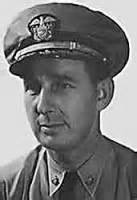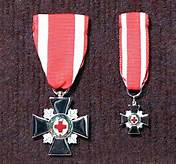Joseph Rochefort
In a conservative service hide-bound by tradition, U.S. Navy Commander Joseph Rochefort was an anomaly. He did not attend the U.S. Naval Academy, was a high school dropout, was blunt and independent, didn’t give a damn about politics and worked at one of those oddball offices doing oddball work that most of the brass thought was useless, namely code-breaking.
It would be many years before the public knew him and his team’s success in breaking the Japanese Naval Code. Breaking that code made the victory at Midway possible, the victory that turned the tide of the war in the Pacific.
Joe Rochefort dropped out of high school to join the U.S. Navy in 1918. His goal was to be a naval aviator, but he was unable to get a transfer into the Navy’s Flying Corps. Instead, he attended the Navy’s Steam Engineering Training School. He focused on military training only and didn’t attend any academic courses. He was commissioned a Navy Ensign. This made him a “mustang,” a nickname for officers who came up through the ranks and didn’t attend the U.S. Naval Academy.
He served aboard a variety of ships until officers noticed his skill with puzzles and recommended him for intelligence work, leading him to a transfer to Washington, D.C. and a post in the cryptanalysis section of the office of the Chief of Naval Operations (CNO). The next year he was put in charge of the unit. Soon he was posted to sea duty, serving as navigator on several vessels. All the while, he yearned for his first love, communications and intelligence.
His break came in 1941 when he was placed in command of a cryptanalysis section in Pearl Harbor, code named HYPO. He and his team intercepted and decrypted Japanese Navy communications.
At HYPO the dress code was casual and he didn’t require his subordinates to address him as “sir” or “commander.” Working in the cold basement of the U.S. Navy building, he often wore a smoking jacket to keep warm. He regularly wore bedroom slippers to soothe his feet after 20 some hours of standing and walking around. This added to the sense of eccentricity fellow officers felt about “the oddballs.”
By 1941, reports of Japanese aggression were making the Navy brass nervous. Rochefort’s team uncovered strong hints in late ’41, such as the changing of encryption and warship call signs.
He didn’t, like most of the Navy brass, think Pearl Harbor would be a target and the devastating raid on December 7th became a sore spot for him for years to come. “… an intelligence officer has one task, one job, one mission. That is to tell his commander what the enemy is going to do tomorrow. This is his job. If he doesn’t do this, then he has failed,” he said ruefully after the attack.
After Pearl Harbor, Rochefort redoubled his efforts, driving himself and his team relentlessly. Twenty-hour days were common and eventually the effort to crack the Japanese Naval codes began to bear fruit. His team uncovered the Japanese Navy’s next move, south towards Australia. They discovered there would be an enemy attack in the Solomon Islands. The Japanese force was a powerful one, containing heavy cruisers, destroyers and three aircraft carriers. This intel helped Admiral Chester Nimitz to put together a makeshift force to intercept the enemy. This led to The Battle of The Coral Sea. The two fleets were 200 miles apart and neither saw nor fired a shot at each other. The battle was fought entirely by carrier borne aircraft.
The battle was essentially a draw. The Navy lost the carrier USS Lexington (the “Lady Lex”), a tanker and a destroyer. The carrier USS Yorktown was damaged. The Japanese lost the light carrier Shoho and a destroyer. Militarily, not a jewel in the crown of the U.S. Navy, but strategically and psychologically, it was a win since it snapped the string of victories enjoyed by Admiral Isoroko Yamamoto’s Combined Fleet. The Japanese honeymoon in the Pacific was over.
Rochefort took about five minutes to enjoy his work, but knew it wasn’t finished. Decoding subsequent Japanese Naval radio traffic, he believed the enemy’s next stop would be in the Central Pacific. His decoders saw the letters “AF” in several messages and discovered that AF stood for Midway Island. They further determined that the attack on the island would be on June 4, 1942, preceded by a diversionary attack in or around Alaska on the 3rd.
Few of the Navy brass bought the idea. Nimitz did, as well as Fleet Admiral Earnest King, CinC of the U.S. Fleet. But there were many naysayers in Naval Intelligence in Washington. They believed the enemy’s next move would be south towards Australia. To prove their conviction about Midway, Lt. Commander Jasper Holmes, a senior member of Rochefort’s team, proposed they “go fishing.” An unencrypted text message would be sent out from Midway complaining that the island’s water distiller system had broken down (it hadn’t) and that the island was low on fresh water. Japanese Intelligence took the bait. They ordered the invasion fleet to take on extra water, thus confirming the target was Midway.
Japan sent a strong fleet. Four of its nine carriers, sixteen submarines, 240 aircraft, twelve cargo ships ferrying 5,000 Japanese Marines and two battleships. Nimitz pulled together the carriers Enterprise, Hornet and recently repaired Yorktown carrying 233 planes and a collection of cruisers and destroyers. The island itself could put 115 planes in the air.
Although outnumbered, the U.S. Navy was waiting for the Japanese. The battle raged for three days. More than 350 Americans were KIA. The USS Yorktown and the destroyer USS Hammann were lost. The Japanese lost all of its carriers, 291 planes, one cruiser, and 4,800 sailors and airmen. It was the turning point in the Pacific war. The U.S. victory was decisive. The Japanese Navy was unable to mount a major offensive operation in the Pacific for the rest of the war. The hunter became the hunted.
Although the U.S. enjoyed a major victory, Joe Rochefort did not. Nimitz recommended him for the Distinguished Service Medal (DSM), but bureaucratic in fighting in Washington blocked the award. The feeling was Joe had been right and they had been wrong and they wouldn’t forgive and forget.
He bounced around the Navy intel world for a while. Tiring of the politics, he finally retired. He dabbled in real estate for a while. His health declining, he served as a consultant for the Hollywood film, “Tora! Tora! Tora!” Later he consulted on the film “Midway” and coached actor Hal Holbrook who played an exaggerated eccentric Rochefort in the movie.
He passed away in 1976 after a heart attack. He was buried at the Inglewood Park Cemetery in Inglewood, California next to his wife.
In the 50s and 60s and 80s, several subordinates tried to get their old boss a DSM, but it languished in U.S. Navy bureaucracy for years. Finally, in 1985, President Ronald Reagan awarded Joe the medal posthumously. Later that year, he was awarded the Presidential Medal of Freedom. In 2000, he was inducted into the Central Security Service Hall of Fame of the U.S. National Security Agency (NSA).


